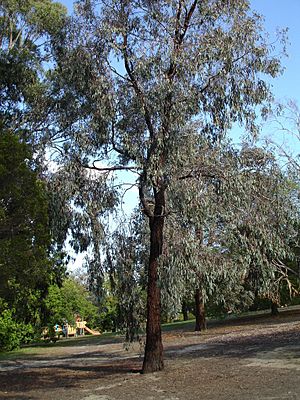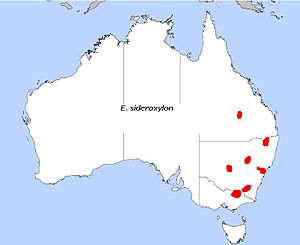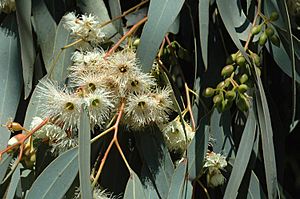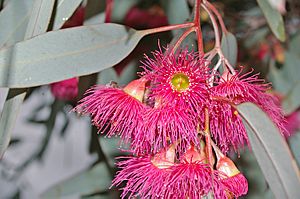Mugga ironbark facts for kids
Quick facts for kids Mugga ironbark, red ironbark |
|
|---|---|
 |
|
| Scientific classification | |
| Genus: |
Eucalyptus
|
| Species: |
sideroxylon
|
 |
|
| E. sideroxylon, field distribution | |
Eucalyptus sideroxylon, commonly known as mugga ironbark, or red ironbark is a small to medium-sized tree that is endemic to eastern Australia. It has dark, deeply furrowed ironbark, lance-shaped adult leaves, flower buds in groups of seven, white, red, pink or creamy yellow flowers and cup-shaped to shortened spherical fruit.
Contents
Description
Eucalyptus sideroxlylon is a tree that typically grows to a height of 25–35 m (82–115 ft) and forms a lignotuber. The bark is dark grey to black, deeply furrowed ironbark on the trunk and larger branches, smooth white to grey on the thinnest branches. Young plants and coppice regrowth have lance-shaped to oblong or linear leaves that are 30–110 mm (1.2–4.3 in) long and 5–35 mm (0.20–1.38 in) wide. Adult leaves are lance-shaped, the same shade of green on both sides, 50–140 mm (2.0–5.5 in) long and 10–40 mm (0.39–1.57 in) wide tapering to a petiole 5–25 mm (0.20–0.98 in) long. The flower buds are arranged in leaf axils on an unbranched peduncle 7–29 mm (0.28–1.14 in) long, the individual buds on pedicels 3–15 mm (0.12–0.59 in) long. Mature buds are oval or diamond-shaped, 6–15 mm (0.24–0.59 in) long and 4–6 mm (0.16–0.24 in) wide with a conical to beaked operculum. Flowering occurs from April to December and the flowers are white, red, pink or creamy yellow. The fruit is a woody cup-shaped to shortened spherical capsule 5–11 mm (0.20–0.43 in) long and 5–10 mm (0.20–0.39 in) wide with the valves below the level of the rim.
Taxonomy and naming
Allan Cunningham recorded the name Eucalyptus sideroxylon in Thomas Mitchell's 1848 Journal of an Expedition into the Interior of Tropical Australia but did not provide a description of the plant. The first formal description of the species was published in 1887 by William Woolls in Proceedings of the Linnean Society of New South Wales. The specific epithet (sideroxylon) is derived from the ancient Greek words sidēros (σίδηρος), meaning "iron" and xylon (ξύλον), meaning "wood".
Two subspecies of E. sideroxylon are accepted by the Australian Plant Census as at December 2019:
- Eucalyptus sideroxylon subsp. improcera A.R.Bean is a small, stunted tree and has shorter, wider leaves than the autonym and longer flower buds;
- Eucalyptus sideroxylon A.Cunn. ex Woolls subsp. sideroxylon.
Distribution and habitat
Mugga ironbark is widespread and often abundant in woodland from south-eastern Queensland through New South Wales to Victoria. Subspecies improcera is only known from the Barakula State Forest north-northwest of Chinchilla.
Uses
The wood is relatively hard and dense, and is often used for firewood. It has very high resistance to rotting and can be used for fence posts, piers, sleepers. Heartwood dark red, sapwood pale yellow. Very dense, hard, fine grained timber, difficult to work, but polishes to a high sheen. Has been used for furniture, turnery, boat-building, benchtops. Popular as a craft furniture timber during the 1990s and early 2000s, Nicholas Dattner famously used ironbark that had been submerged as a wharf pier for 80 years in a range of tables. At about 1130 kg/m3 it is one of the few timbers that will not float.
The leaves are used in the production of cineole based eucalyptus oil.
Apiarists in New South Wales place hives in red-ironbark woodlands to collect the honey.
Use in horticulture
They are easy to grow from seed and are usually quite true to the parent in form. They are very hardy, needing less than 400mm of rain per year to survive, yet can grow in climates with more than 1000mm/y.
Chemistry
Molecules produced by plants in case of pathogens attacks are called phytoalexins. Such compounds can be implied in the hypersensitive response of plants. High levels of polyphenols (stilbenoids and ellagitannins) in E. sideroxylon wood can explain its natural preservation against rot.
See also
 In Spanish: Mugga para niños
In Spanish: Mugga para niños



